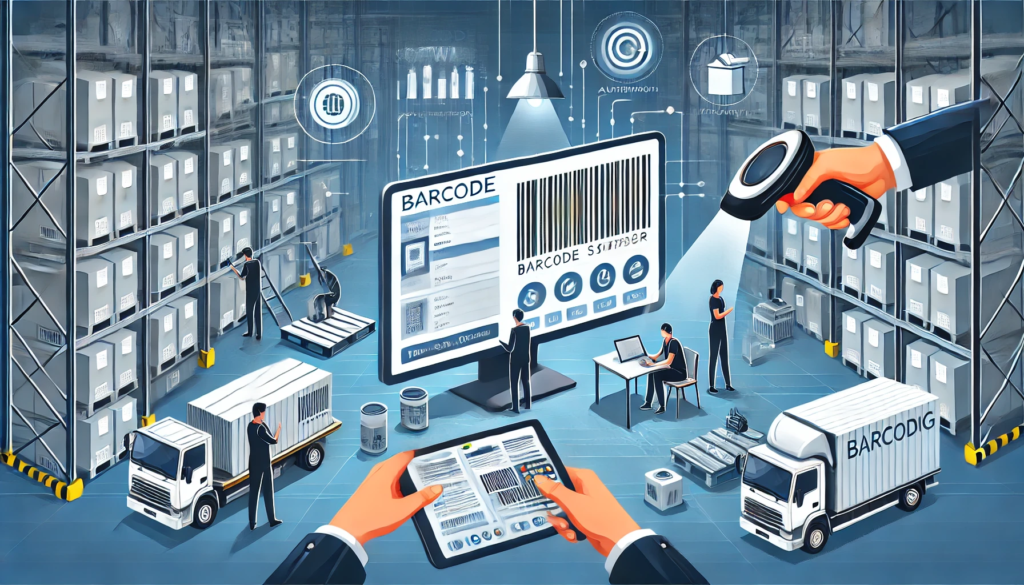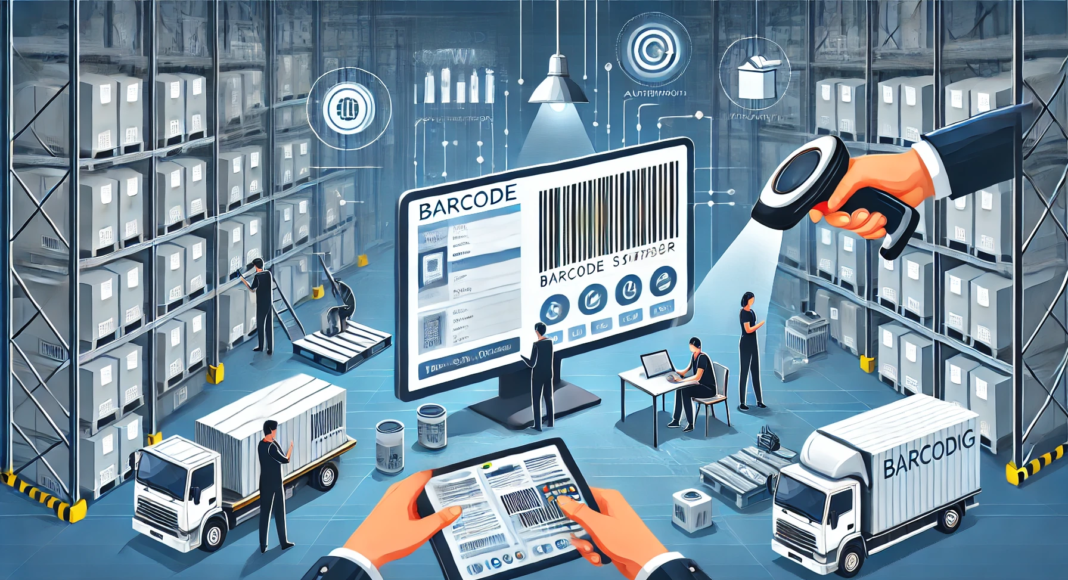Key Takeaways
- Barcoding software adoption is rapidly increasing across industries, driven by the need for real-time data and inventory management efficiency.
- Emerging trends such as mobile barcoding apps, AI integration, and RFID technology are revolutionizing the way businesses track and manage products.
- The global market for barcoding software is poised for continued growth, with businesses leveraging these solutions to enhance supply chain visibility and operational accuracy.
In today’s fast-paced business world, barcoding software has become an integral part of industries ranging from retail to manufacturing, logistics, healthcare, and more.
As businesses strive for efficiency, accuracy, and cost-effectiveness in their operations, the role of barcoding software cannot be overstated.
Barcoding technology is pivotal in automating data capture, inventory management, product tracking, and ensuring seamless communication between various systems. It enables businesses to operate with precision, providing real-time insights and improving decision-making processes.
Also, read our Top 8 Best Barcoding Software in 2025 here.

With advancements in technology, barcoding solutions have evolved significantly.
What was once a simple tool for scanning product labels has transformed into an indispensable asset, integrated with cloud systems, AI capabilities, and mobile platforms, enhancing business agility.
In this comprehensive guide, we explore the most up-to-date statistics, data, and trends surrounding barcoding software.
These insights reflect the current state of the industry and shed light on how barcoding technology is shaping various sectors.
From the adoption rate of barcoding software across industries to the latest innovations and market forecasts, this article provides an in-depth look at what’s driving the growth and adoption of barcoding solutions worldwide.
The demand for more streamlined inventory systems, enhanced traceability, and the growing importance of real-time data are some of the key drivers behind the surge in barcoding software adoption.
Furthermore, with the rise of e-commerce, supply chain complexities, and a globalized market, barcoding solutions are continually evolving to meet new challenges and expectations.
In this blog, we delve into the top 40 latest statistics, key trends, and projections that highlight the future trajectory of the barcoding software market.
Whether you are a business owner looking to optimize your operational processes or a technology enthusiast eager to understand the advancements in barcode technology, this guide will provide valuable insights to navigate the dynamic barcoding landscape.
By exploring the latest data on market growth, key features of barcoding solutions, industry-specific applications, and emerging trends, you’ll gain a comprehensive understanding of how barcoding software is shaping the future of modern business operations.
Before we venture further into this article, we would like to share who we are and what we do.
About 9cv9
9cv9 is a business tech startup based in Singapore and Asia, with a strong presence all over the world.
With over nine years of startup and business experience, and being highly involved in connecting with thousands of companies and startups, the 9cv9 team has listed some important learning points in this overview of the Top 40 Latest Barcoding Software Statistics, Data & Trends.
If your company needs recruitment and headhunting services to hire top-quality employees, you can use 9cv9 headhunting and recruitment services to hire top talents and candidates. Find out more here, or send over an email to [email protected].
Or just post 1 free job posting here at 9cv9 Hiring Portal in under 10 minutes.
Top 40 Latest Barcoding Software Statistics, Data & Trends
- Global Barcoding Software Market Size (2024): The global barcoding software market is projected to reach approximately USD 5.1 billion by the end of 2024, reflecting a significant growth trend in the industry.
- Projected Global Barcoding Software Market Size (2033): By 2033, the global barcoding software market is expected to expand to USD 12.6 billion, driven by increasing demand for efficient inventory management solutions.
- CAGR of Barcoding Software Market (2026-2033): The barcoding software market is anticipated to grow at a compound annual growth rate (CAGR) of 10.5% from 2026 to 2033, driven by technological advancements and adoption across various industries.
- Global Barcoding Software Market Size (2022): In 2022, the global barcoding software market was valued at approximately USD 1.01 billion, indicating a strong foundation for future growth.
- Projected Global Barcoding Software Market Size (2030): By 2030, the global barcoding software market is projected to reach USD 3.58 billion, reflecting a robust expansion driven by digital transformation initiatives.
- CAGR of Barcoding Software Market (2022-2030): The barcoding software market is expected to experience a compound annual growth rate (CAGR) of around 17.4% from 2022 to 2030, driven by increased adoption in retail and manufacturing sectors.
- Global Inventory Management Software Market Size (2025): The global inventory management software market is anticipated to reach USD 10.57 billion by 2025, highlighting the growing importance of inventory management solutions.
- 2D Barcode Reader Market Size (2024): The 2D barcode reader market is projected to be valued at USD 8.14 billion by 2024, reflecting the widespread adoption of 2D barcodes in various industries.
- CAGR of 2D Barcode Reader Market (2025-2030): From 2025 to 2030, the 2D barcode reader market is expected to grow at a CAGR of 9.4%, driven by advancements in scanning technology and increased use in healthcare and logistics.
- CAGR of Barcoding Software Market (Forecast Period): During the forecast period, the barcoding software market is anticipated to grow at a CAGR of 9.5%, driven by the need for efficient supply chain management and inventory tracking.
- Reduction in Inventory Discrepancies with Barcoding: The implementation of barcoding can reduce inventory discrepancies by up to 25%, significantly improving inventory accuracy and reducing operational costs.
- Increase in Overall Efficiency with Barcoding: Barcoding can increase overall operational efficiency by up to 30%, enhancing productivity and streamlining business processes.
- Small Businesses Failure Rate Within the First Year: Approximately 20% of small businesses fail within their first year, often due to inefficient inventory management and operational inefficiencies that barcoding can help mitigate.
- Cost of Implementing Barcoding Software: The cost of implementing barcoding software varies widely, but it can be a significant barrier for small and medium-sized enterprises (SMEs) due to initial investment requirements.
- Number of Integrations Supported by Deskera: Deskera supports over 2,000 application integrations, providing comprehensive connectivity for businesses using its barcoding solutions.
- Price of Kladana’s Basic Plan: Kladana’s basic plan starts at approximately $60 per year, offering an affordable entry point for small businesses looking to implement barcoding solutions.
- Price of Zoho’s Premium Plan: Zoho’s premium plan for inventory management starts at around $130 per month, providing advanced features for larger businesses.
- Price of TranZact’s Enterprise Plan: TranZact’s enterprise plan is priced from $360 per month, catering to large-scale operations requiring robust barcoding and inventory management capabilities.
- Price of Deskera’s Plan: Deskera’s comprehensive plan starts at approximately $1,000 per month, offering advanced features suitable for large enterprises.
- Price of Sortly’s Ultra Plan: Sortly’s ultra plan is priced from $60 per month, providing a cost-effective solution for businesses needing advanced inventory tracking features.
- Price of Vyapar’s Plan: Vyapar’s plan starts at around $7 per month, offering an affordable option for small businesses looking to implement basic barcoding solutions.
- Price of Katana’s Standard Plan: Katana’s standard plan is priced from $360 per month, providing a robust solution for manufacturing and inventory management needs.
- Price of EZOfficeInventory’s Advanced Plan: EZOfficeInventory’s advanced plan is more pricey than the basic plan, starting at $35 per month, offering additional features for larger operations.
- Price of Mintsoft’s Medium Plan: Mintsoft’s medium plan is priced from $420 per month, catering to businesses requiring more comprehensive inventory management capabilities.
- Price of Salesbinder’s Plan: Salesbinder’s plan starts at approximately $10 per month, providing an entry-level solution for small businesses.
- Number of Pages in the Barcoding Software Market Report: The comprehensive barcoding software market report spans over 210 pages, providing detailed insights into market trends and forecasts.
- Year of Zoho’s Establishment: Zoho was established over 25 years ago, marking a long history of providing innovative software solutions, including barcoding and inventory management tools.
- Year of Kladana’s Establishment: Kladana was established 17 years ago, offering a range of barcoding and inventory management solutions tailored to various business needs.
- Number of Onboarding Sessions for Kladana: Kladana typically requires 1-3 onboarding sessions to ensure smooth integration and effective use of its barcoding software.
- Response Time for Kladana Support: Kladana’s support team responds within 5-15 minutes, ensuring prompt assistance for users of its barcoding solutions.
- Number of Mobile Apps Provided by Zoho: Zoho offers multiple mobile apps, allowing users to manage inventory and barcoding tasks on-the-go across various devices.
- Number of Scanning Devices Supported by Katana: Katana supports multiple scanning devices, including USB, Bluetooth, and mobile scanners, providing flexibility in inventory tracking.
- Number of Industries Supported by Sortly: Sortly supports various industries, including education, jewelry, medicine, and construction, offering tailored barcoding solutions for each sector.
- Number of Integrations Supported by Mintsoft: Mintsoft supports over 150 integrations, enabling seamless connectivity with other business systems for comprehensive inventory management.
- Year of the Latest Barcoding Software Market Report: The latest barcoding software market report was published in March 2025, providing up-to-date insights into market trends and future projections.
- Study Period for the Barcoding Software Market Report: The study period for the barcoding software market report spans from 2023 to 2033, offering a comprehensive analysis of past and future market dynamics.
- CAGR of 2D Barcode Reader Market in Europe (2025-2030): In Europe, the 2D barcode reader market is expected to grow at a CAGR of over 6% from 2025 to 2030, driven by increased adoption in retail and healthcare sectors.
- Year of the 2D Barcode Reader Market Report: The 2D barcode reader market report was published in January 2024, highlighting current market conditions and future growth prospects.
- Projected Year for the 2D Barcode Reader Market Size Estimate: The projected market size estimate for the 2D barcode reader market is for the year 2030, reflecting anticipated growth and technological advancements.
- Year of the Global Inventory Management Software Market Size Estimate: The global inventory management software market size estimate for 2025 reflects the growing demand for efficient inventory management solutions across industries.
Conclusion
The landscape of barcoding software has undergone dramatic transformations, thanks to continuous advancements in technology, the increasing need for operational efficiency, and the rapid growth of industries relying on real-time data. As we’ve explored in this guide, the latest barcoding software statistics, data, and trends highlight how the integration of cutting-edge technologies such as cloud computing, AI, and mobile platforms are reshaping the industry. The future of barcoding software is brighter than ever, driven by the pursuit of enhanced accuracy, seamless supply chain management, and the optimization of inventory control systems across industries worldwide.
Looking ahead, the growth of e-commerce, the push for greater supply chain visibility, and the increasing reliance on automation and data-driven decision-making will continue to fuel the adoption of advanced barcoding solutions. As businesses strive to meet the demands of a rapidly changing market, barcoding software has become more than just a tool for tracking products. It is now a vital component of digital transformation, enabling businesses to increase operational efficiency, reduce human error, and gain deeper insights into their processes.
The statistics presented in this blog paint a clear picture of the growing importance of barcoding technology in modern business operations. From its role in inventory management to its applications in healthcare, logistics, and retail, barcoding software is at the forefront of a data-driven revolution. As organizations recognize the value of accurate, real-time information, the demand for sophisticated barcoding solutions is set to rise. Trends such as the increasing adoption of mobile barcoding apps, the integration of IoT and RFID technology, and the growing focus on data security and regulatory compliance are poised to shape the future of barcoding software.
For businesses, the decision to invest in the latest barcoding solutions is no longer a mere operational choice; it is a strategic one. Whether you are looking to streamline your inventory processes, enhance product traceability, or improve customer satisfaction, the benefits of implementing modern barcoding software are undeniable. As the market continues to expand, keeping up with the latest trends and innovations will be essential to staying competitive in an increasingly technology-driven world.
In conclusion, barcoding software is not only revolutionizing the way businesses manage their operations but is also laying the foundation for the next wave of innovation in supply chain and data management. The latest statistics and trends underscore the pivotal role this technology plays in industries across the globe. As companies continue to embrace these solutions, the future of barcoding software is filled with potential, offering businesses unparalleled opportunities for growth, efficiency, and success. By staying informed on the latest developments and adopting the most advanced barcoding solutions, businesses can position themselves for continued success in an increasingly digital and interconnected world.
If you find this article useful, why not share it with your hiring manager and C-level suite friends and also leave a nice comment below?
We, at the 9cv9 Research Team, strive to bring the latest and most meaningful data, guides, and statistics to your doorstep.
To get access to top-quality guides, click over to 9cv9 Blog.
People Also Ask
What is barcoding software and why is it important?
Barcoding software is used to automate the process of capturing data from barcodes, improving inventory management, tracking products, and increasing operational efficiency. It is essential for businesses aiming to streamline their operations and reduce errors.
How does barcoding software benefit businesses?
Barcoding software enhances accuracy, saves time, improves inventory management, reduces human error, and provides real-time data. It helps businesses optimize supply chains and makes tracking products from warehouse to retail seamless.
What industries use barcoding software?
Barcoding software is used across various industries, including retail, logistics, healthcare, manufacturing, and distribution. It plays a crucial role in inventory tracking, order fulfillment, and asset management in these sectors.
What are the latest trends in barcoding software?
The latest trends include mobile barcoding apps, RFID and IoT integration, cloud-based solutions, AI-powered features, and increased emphasis on data security. These advancements enhance efficiency, data accessibility, and real-time decision-making.
How is AI used in barcoding software?
AI enhances barcoding software by enabling smarter data analysis, predictive inventory management, and automated decision-making. It also helps improve the accuracy of barcode scanning and product tracking.
What is the future of barcoding technology?
The future of barcoding technology includes more integration with AI, machine learning, RFID, and IoT. These advancements will provide even more automation, accuracy, and real-time tracking for businesses across industries.
Why is mobile barcoding becoming popular?
Mobile barcoding is popular because it allows businesses to perform barcode scans on smartphones or tablets, improving mobility, flexibility, and cost-effectiveness, especially for workers in warehouses and field operations.
How does RFID improve barcoding systems?
RFID enhances barcoding systems by enabling contactless scanning and tracking of products in real-time, even when they are out of sight. This improves inventory accuracy and reduces human error.
What is the role of cloud technology in barcoding software?
Cloud technology allows for the remote access and storage of barcode data, making it easier to manage inventory and track products across multiple locations. It also enables real-time updates and collaboration between teams.
How does barcoding software improve inventory management?
Barcoding software automates inventory tracking, reducing the risk of stockouts and overstocking. It provides real-time insights into inventory levels, helping businesses maintain optimal stock and streamline their supply chain.
What are the key features of modern barcoding software?
Modern barcoding software typically includes mobile compatibility, real-time data syncing, cloud storage, barcode generation and scanning, RFID support, and AI-powered analytics to improve operational efficiency.
Can barcoding software be integrated with other systems?
Yes, barcoding software can be integrated with various business systems, including ERP, CRM, and warehouse management systems, providing a unified solution for tracking, inventory management, and reporting.
How does barcoding software enhance supply chain management?
Barcoding software improves supply chain management by providing real-time visibility into inventory, reducing errors, speeding up order processing, and optimizing product traceability throughout the supply chain.
What are the benefits of using cloud-based barcoding software?
Cloud-based barcoding software offers benefits such as remote access, real-time updates, scalability, reduced IT infrastructure costs, and easier integration with other cloud-based business tools.
What is the difference between 1D and 2D barcodes?
1D barcodes store information in a linear format, typically used for product identification. 2D barcodes, like QR codes, store more data, including links, images, and complex information, allowing for enhanced tracking and marketing capabilities.
How secure is barcoding software?
Modern barcoding software incorporates robust security features like encryption, secure cloud storage, and access controls, ensuring that sensitive data is protected from unauthorized access and cyber threats.
What are the main challenges of implementing barcoding software?
Challenges include high initial costs, integration with existing systems, employee training, and ensuring data accuracy during setup. Overcoming these hurdles leads to long-term operational efficiency.
How does barcoding software help reduce human error?
By automating data capture and minimizing manual input, barcoding software reduces the likelihood of human error in inventory management, product tracking, and data entry processes.
Can barcoding software be used in healthcare?
Yes, barcoding software is widely used in healthcare for tracking medications, patient records, equipment, and supplies. It enhances patient safety and ensures that medical professionals have access to accurate, real-time data.
What are the cost savings associated with barcoding software?
Barcoding software helps reduce costs by improving efficiency, reducing labor expenses, minimizing errors, and optimizing inventory management. It also prevents losses caused by inaccurate data or stockouts.
How does barcoding software integrate with AI-powered inventory management?
Barcoding software integrates with AI-powered inventory systems to enhance predictive analytics, optimize stock levels, and automate reordering processes, improving overall inventory control and reducing operational inefficiencies.
What is the role of barcoding in e-commerce?
In e-commerce, barcoding helps manage inventory, streamline order fulfillment, and improve shipping accuracy. It ensures that products are tracked accurately from the warehouse to the customer, enhancing the overall customer experience.
How does barcoding software affect warehouse operations?
Barcoding software improves warehouse operations by automating the tracking of products, reducing manual labor, speeding up order picking and packing processes, and providing real-time inventory updates.
What are some examples of industries benefiting from barcoding software?
Retail, logistics, manufacturing, healthcare, and transportation are just a few industries benefiting from barcoding software. Each uses it to streamline inventory management, improve product traceability, and optimize supply chains.
What is the role of barcoding software in tracking shipments?
Barcoding software helps businesses track shipments by scanning barcodes on packages, providing real-time data on location, status, and delivery, ensuring accuracy and timely delivery throughout the shipping process.
How can barcoding software improve customer satisfaction?
Barcoding software enhances customer satisfaction by improving order accuracy, reducing delivery times, and ensuring better inventory management, all of which contribute to a smoother shopping experience and fewer errors in orders.
Can barcoding software be customized for specific business needs?
Yes, barcoding software can be customized to meet the unique needs of different industries and business operations. This includes integrating specific functionalities, adjusting features, and tailoring workflows to match business requirements.
What is the impact of barcoding on data accuracy?
Barcoding improves data accuracy by eliminating the need for manual data entry, reducing the risk of errors, and providing precise tracking and reporting through automated scanning and real-time updates.
How does barcoding software help with compliance?
Barcoding software ensures compliance with industry regulations by providing accurate product traceability, inventory reporting, and adherence to standards required in sectors like healthcare, food safety, and manufacturing.
What are some future innovations in barcoding software?
Future innovations include increased integration with IoT, AI-driven analytics, enhanced RFID capabilities, and the use of blockchain for more secure and transparent product tracking across global supply chains.
How do small businesses benefit from barcoding software?
Small businesses benefit by automating inventory tracking, reducing operational costs, improving accuracy, and streamlining their workflows, all of which enable them to compete more effectively with larger companies.
What are the environmental benefits of using barcoding software?
Barcoding software can reduce paper waste by automating data capture and reducing reliance on printed records. It also helps optimize supply chains, reducing transportation costs and the carbon footprint of businesses.
What is the ROI of implementing barcoding software?
The ROI of barcoding software is significant, with businesses experiencing reduced labor costs, improved inventory accuracy, fewer errors, and better decision-making through real-time data, all contributing to long-term savings.
How can businesses ensure the successful implementation of barcoding software?
Successful implementation requires thorough planning, staff training, choosing the right software solution, ensuring system integration, and continuous monitoring to optimize the use of barcoding technology for business needs.
Sources:
- Kladana Blog
- Verified Market Reports
- Grand View Research
- MarketsandMarkets
- Zoho Website
- Deskera Website
- Sortly Website
- Katana Website
- Mintsoft Website
- Capterra
- Small Business Administration































![Writing A Good CV [6 Tips To Improve Your CV] 6 Tips To Improve Your CV](https://blog.9cv9.com/wp-content/uploads/2020/06/2020-06-02-2-100x70.png)


